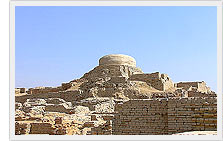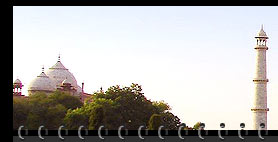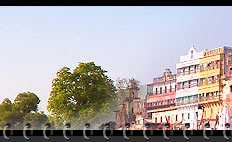Ancient India
Ancient India History
The Indus Valley Civilisation, Harrapa | Aryans and the Vedic Age | Rise of
Religions and Emergence of the State | The Gupta Age | The Southern Kingdoms

The
Indus Valley Civilization existed in between 3000-1500 BC while the earlier
Kot Diji cultures, of the pre-Indus period, existed in the period of
approximately 3300-2800 BC. Harappa and the city of Mohenjo-Daro were the
greatest achievements of the Indus valley civilization. These cities are
well known for their impressive, organized and regular layout.
Then came Aryans who composed these evocative hymns to nature and
celebrated life exuberantly referred to them as Aryas usually anglicised as
Aryan meaning 'noble'. The 6th Century B.C. was the period of Magadh
Kingdom. Chandragupta Maurya ousted the oppressive ruler of Magadh to find
his own dynasty that existed from 322 - 298 B.C.
The most famous Maurya King Ashoka the Great ruled from 273 - 232 B.C over
a large kingdom stretching from Kashmir and Peshawar in the North and
Northwest to Mysore in the South and Orissa in the East. He after witnessing
the carnage at the battle field of Kalinga (269 B.C.) in Orissa, dedicated
himself to Dharmma (righteousness).
In the subsequent centuries, after the Ashoka empire disintegrated, India
suffered a series of invasions, and often fell under the spell of foreign
rulers - Indo Bactrians, the Sakas and others. After the next 400 years of
instability the Guptas established their kingdom.
Kalidas, the famous Sanskrit poet and dramatist, author of Abhijnana
Shankuntalam, Kumarsambhavam and Meghadutam is believed to have adorned the
Gupta court. Also the great mathematicians like Aryabhatta and astronomers
like Varahmihir lived during this period. The dazzling wall paintings of the
Ajanta caves too are traced back to this era.
Cholas, Pandayas and Pallavas ruled over the southern part of India during
the medieval period of India’s history. Cholas ruled the territory of
Deccan (today the districts of Thanjavur and Tiruchirapally) while the
Pandyas reined around present day Tirunelvelli and Madurai.
Pallavas of Kanchi rose to prominence in the 4th Century A.D. and ruled
unchallenged for about four hundred years. The Nayanar and Alvar saint poets
belong to this period. The gemlike shore temples at Mahabalipuram date to
this period. The Cholas overthrew the Pallavas were in the 9th Century and
regained political primacy in south India. The 15th Century saw the decline
of the Pandyas.



 The
Indus Valley Civilization existed in between 3000-1500 BC while the earlier
Kot Diji cultures, of the pre-Indus period, existed in the period of
approximately 3300-2800 BC. Harappa and the city of Mohenjo-Daro were the
greatest achievements of the Indus valley civilization. These cities are
well known for their impressive, organized and regular layout.
The
Indus Valley Civilization existed in between 3000-1500 BC while the earlier
Kot Diji cultures, of the pre-Indus period, existed in the period of
approximately 3300-2800 BC. Harappa and the city of Mohenjo-Daro were the
greatest achievements of the Indus valley civilization. These cities are
well known for their impressive, organized and regular layout.